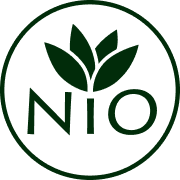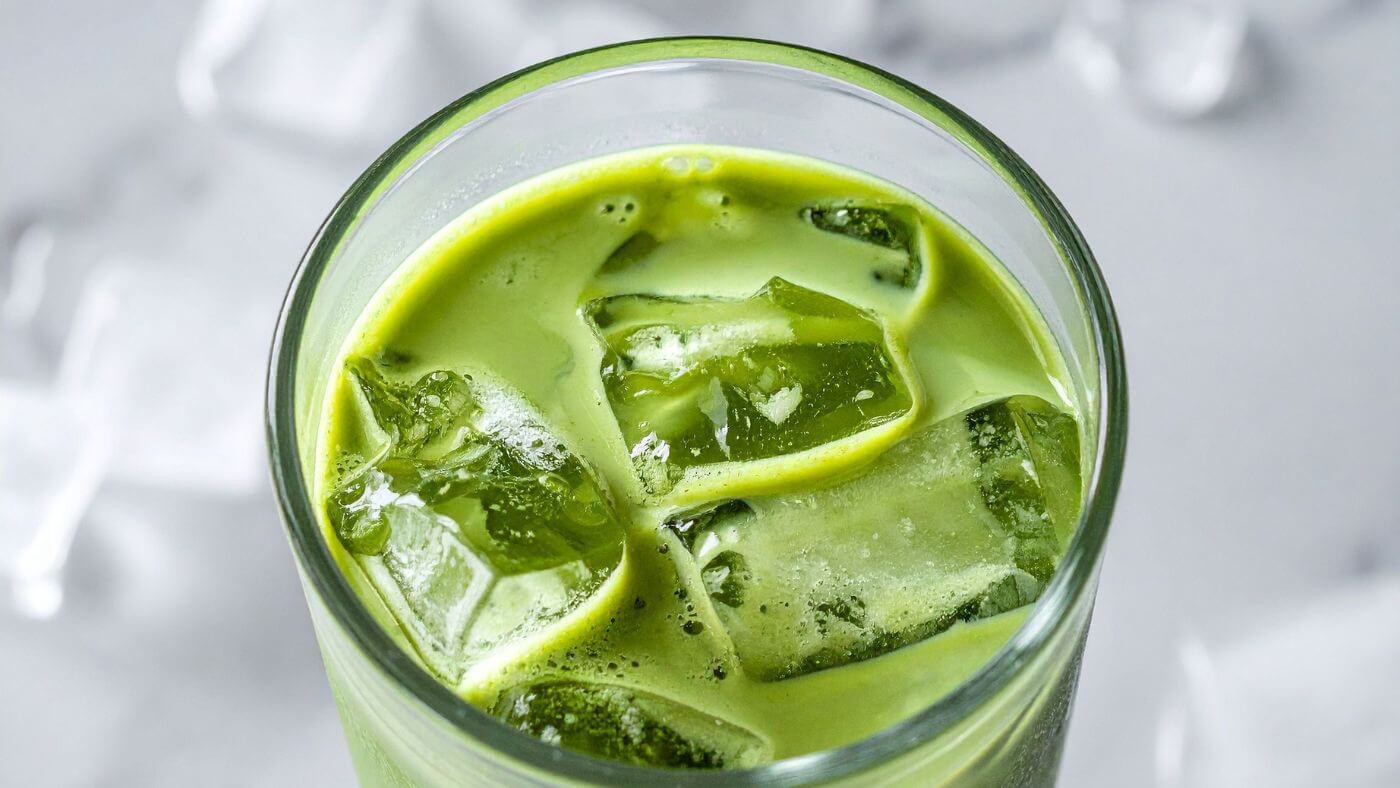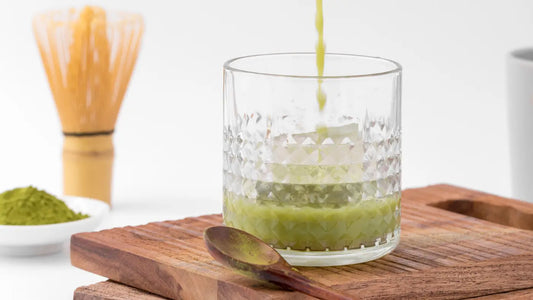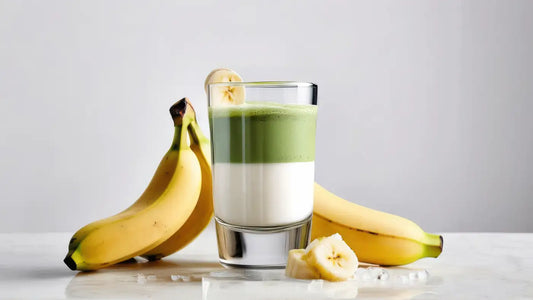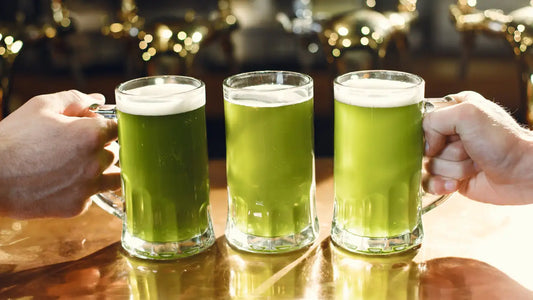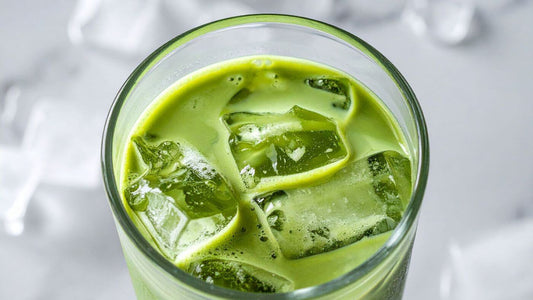From Quick Shake to Smooth Infusion: our Personal Cold Brew Matcha Technic
So how do you actually cold brew matcha? 🤔
In the previous section, we explained how to cold brew matcha using the mason jar method that can sometimes be a tricky subject.
Now, let’s go step by step through the real method you can use to prepare a delicious matcha cold brew at home "the infuse method".
The Smooth Infusing Cold Brew Matcha Method
This is considered the “true” cold brew method for matcha. Instead of simply mixing the powder with water, the flavor is gently extracted over time. An added benefit of this approach is that it avoids the formation of clumps, resulting in a smooth and refreshing drink.
Step 1: Adding the matcha powder
Place a tea strainer on top of a glass or jar and add 1 teaspoon (about 2 grams) of matcha powder.
Step 2: Adding the water
Slowly pour 8 oz (235 ml) of cold filtered water through the strainer. Dip the strainer a few times to make sure all the powder is fully submerged.
Step 3: Brewing the cold brew matcha
Allow the matcha to sit for about 1 hour. Because cold water extracts more slowly than hot water, this resting period is needed to bring out the delicate flavors of the tea.
Step 4: Serving the cold brew
Once brewed, remove the strainer and pour the tea into a glass with ice cubes. Your smooth and refreshing cold brew matcha is ready to enjoy!
Perfect container for your matcha cold brew
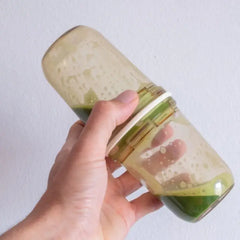
What kind of container works best?
The mason jar is by far our favorite one!
Ideally, choose one that is food-safe, transparent, has a wide mouth, and a secure lid. This way you can easily add your matcha, monitor the extraction, and shake if needed.
A simple mason jar works perfectly for this method.
By the way, did you know that the mason jar is one the best substitutes to prepare a matcha without a whisk?
Matcha cold brew ratio
Here’s the ideal ratio to keep in mind when making cold brew matcha:
- 1 tsp (2g) matcha powder
- 8 oz (235 ml) cold water
- Ice cubes
Cold brew matcha tends to have a milder flavor compared to hot matcha. To avoid a diluted taste, don’t skimp on the powder. The upside is that cold brewing also reduces bitterness, making the tea smoother and easier to drink.
How to make a cold brew matcha latte
Can you turn cold brew matcha into a latte? Technically yes, but it’s not the best option. The reason is that cold brew matcha is lighter in flavor and can be overpowered by milk. Instead, we recommend the following method for a tastier iced latte:
Alternative to the cold brew matcha latte
Start by whisking 2 teaspoons of matcha with 2 tablespoons of warm water to form a smooth paste. Don’t worry about the water being hot — the small amount will cool down quickly. Once the clumps are dissolved, add about ⅔ cup of cold milk. This way, the flavor is stronger and the matcha stands out beautifully against the milk.
We’ve tested this side by side with a true cold brew latte, and the flavor is consistently richer when starting with warm water. The extraction is simply more complete.
3 benefits of cold brew matcha

#1 Flavor
Cold brew matcha offers a smoother, more refreshing taste. The cool water extracts less bitterness, leaving you with a naturally sweet, mellow flavor — perfect for summer or a gentle energy boost.
#2 Health benefits
When you prepare matcha using the shaking method, you’re still drinking the entire tea leaf. This means cold brew matcha delivers the same antioxidants, amino acids, and nutrients as hot matcha.
If you’d like to dive deeper into the specific health benefits, check out our detailed guide here.
#3 Convenience
Another great benefit of cold brew matcha is convenience. Using the shaker method, you can have your matcha ready in under a minute. If you use a mason jar or bottle with a lid, cleanup is quick and easy — just pop it in the dishwasher afterwards.
Caffeine content in cold brew matcha

How much caffeine does cold brew matcha have?
Unlike cold brew teas, the caffeine content remains the same as hot matcha because you consume the whole leaf.
One teaspoon of matcha typically contains about 68mg of caffeine.
If you use the infusion method with a strainer, the amount of caffeine depends on how much powder passes through.
If almost all of it is extracted, you’ll be close to the full 68mg.
Can you cold brew matcha overnight?
Absolutely! Leaving matcha to brew overnight results in a stronger flavor. Experiment with different brewing times to find the taste you prefer. Just remember to always use high-quality ceremonial matcha, as you’ll be drinking it plain without milk or sweeteners.
Cold Brew Showdown: Matcha vs Green Tea
Matcha is unique compared to other teas because it is mixed directly into water rather than just infused. This means you’re drinking suspended tea leaf particles, not just an extraction. At the same time, matcha also “brews” in the water, especially in hot water, creating a full-bodied flavor. With cold water, the brewing is slower and requires a little more care to get right.
The challenge with cold brew matcha
One of the main challenges with cold brewing matcha is clumping. Because matcha powder is so fine, it tends to stick together when it comes into contact with cold water. This is why sifting the powder or shaking vigorously is essential to achieve a smooth drink.
Now that you understand the basics and the challenges, you’re ready to try making your own cold brew matcha at home!
